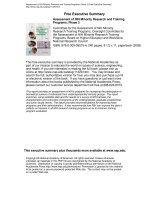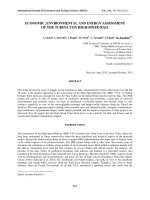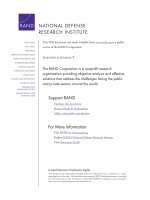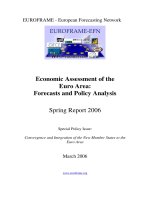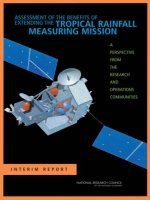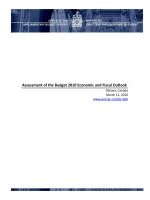ASSESSMENT OF ANTIBACTERIAL AND ANTIINFLAMMATORY EFFECTS OF EXTRACTS OF MANGOSTEEN LEAVES
Bạn đang xem bản rút gọn của tài liệu. Xem và tải ngay bản đầy đủ của tài liệu tại đây (129.04 KB, 11 trang )
Cantho University
Research Proposal
B1904xxx
ASSESSMENT OF ANTIBACTERIAL AND ANTI-INFLAMMATORY
EFFECTS OF EXTRACTS OF MANGOSTEEN LEAVES
Abstract
This study is aimed to assess the antibacterial and anti-inflammatory effects of
mangosteen (Garcinia mangostana L.) leaves through extracts. Phytochemical tests,
disc diffusion assay, and bovine serum albumin denaturation assay are performed to
identify and measure biological compounds, the antibacterial, and anti-infammatory
effects, respectively. The extract of mangosteen leaves with the hypothesized
antibacterial and anti-inflammatory effects will be a potential source for treating
various infectious and chronic diseases.
Keywords: Mangosteen, antibacterial effect, anti-inflammatory effect
Literature Review
Mangosteen (Garcinia mangostana L.) which is part of the Guttiferae family,
known as the purple mangosteen or mangosteen, (Stone, 2016). Mangosteen is a
tropical fruit typically grown in tropical South East Asian countries such as Malaysia,
Indonesia, and Thailand (Aizat et al., 2019).
Mangosteen is round with thick skin (or also called pericarp) and ripens
seasonally, from green to yellow to pink spotted and finally full purple colored fruit
(Abdul-Rahman et al., 2017; Parijadi et al., 2018). The edible portion of the fruit
resides within the pericarp, comprising of three to more than eight septa, white in
color and having sweet-sour taste. It is called ‘‘The Queen of Fruits” being among the
best tasting tropical fruits (Stone, 2016). Mangosteen consists of chemical
compounds, such as xanthones, phenol, flavonoids, saponins, tannins, anthocyanins,
terpenes, vitamins B1, B2, and other bioactive substances supporting its medicinal
properties (Aljunaid et al., 2020). In traditional medicine, Mangosteen has been used
to treat skin infections and diarrhea. Recent scientific studies suggest that mangosteen
possesses strong antioxidant, anti-cancer, anti-inflammatory, anti-allergic, antimicrobial, and anti-malarial properties.
Mangosteen is a fruit as a daily meal of human. We can buy these fruits in
anywhere and anytime at markets. Beside consuming fruits as eating fleshing fruits,
some products of fruits such as juices and beverages made.
Nowadays, many studies indicate that mangosteen fruits have many health
benefits for human health. Mangosteen is a functional plant because most of the plants
can be used as medicine (Suhartati et al., 2019). The parts of a mangosteen plant that
have been widely used are flesh, pericarp and stems, while mangosteen leaves have
not been widely used as ingredients of traditional medicine (Suhartati et al., 2019).
The previous studies have been performed on extracts of mangosteen pericarp (Do et
al., 2020; Oh et al., 2020). In fact, mangosteen leaves have not been specifically
studied for their antibacterial and anti-inflammatory effects.
Thus, the study "Assessment of antibacterial and anti-inflammatory effects of
extracts of Mangosteen leaves." will carried out. The topic would aid in many further
study that concern about ingredients of traditional medicine from popular plants.
Materials and Methods
Sample preparation
Mangosteen leaves are collected, washed, and dried at room temperature (25 oC)
followed by crushing into a fine powder. The powdered plant material (about 50
grams) is extracted by using Soxhlet extraction technique. The crushed leaves is
extracted with 350mL of 95% ethanol. The excess ethanol is recovered and the crude
extract is filtered with ether solution, which are then preserved at 4oC.
Phytochemical tests
According to Rathod et al. (2022), phytochemical tests of crude extract are
conducted to identify the presence of phytochemicals by following the standard
qualitative assays such as Biuret test, Molisch test, Salkowski test, Murexide test, and
others.
- Test for proteins
Biuret test is utilized. The extract is added to 1mL of 40% sodium hydroxide
and 2 drops of 1% copper (II) sulfate solution. A violet color will indicate the
presence of proteins.
- Test for carbohydrates
Molisch test is utilized. The extract is added to 2 drops of the Molisch reagent
(a solution of α-Naphthol in 95% ethanol). The solution is then added to a few drops
of concentrated sulfuric acid along the sides of the test tube. The formation of a purple
or reddish-violet color at the interface of two layers will indicate the presence of
carbohydrates.
- Test for phenolic compound
A few drops of 5% ferric chloride solution are added to 1mL of the extract
solution. A dark green or bluish-black color will indicate the presence of phenols.
- Test for flanovoids
A few drops of dilute sodium hydroxide solution are added to 1mL of the
extract. An intense yellow color is appeared in the test tube. The solution is then
added to a few drops of dilute hydrochloric acid solution. The resulting solution will
be colorless because of the presence of flavonoids.
- Test for terpenoids
A few drops of acetic anhydride are added to 1mL of the extract, and 2 drops of
concentrated sulfuric acid are then added. The presence of a reddish-brown color will
indicate the presence of terpenoids.
- Test for steroids
Salkowski test is utilized. The extract is dissolved in an equal volume of
chloroform, and a few drops of concentrated sulfuric acid are then added along the
sides of the test tube. A bluish-red to cherry red color will observe in the upper layer,
and the lower layer will show with green fluorescence, indicating the presence of
steroids.
- Test for tannins
The extract is added to distilled water. A few drops of ferric chloride solution
are then added. A dark-blue or greenish-black color will indicate the presence of
tannins.
- Test for caffeine
Murexide test is utilized. A few drops of the extract and an equal volume of
nitric acid solution are added in a small porcelain disc. The sample is then evaporated
until it is dry. After that, a few drops of ammonium hydroxide are added. A purple
color will indicate the presence of caffeine.
Antimicrobial activity measurement
Disc diffusion assay is one method for quantifying the ability of antibiotics to
inhibit bacterial growth (Hemeg et al., 2020; Amin et al., 2021; Nayak et al., 2021).
The 6-mm-diameter discs of Whatman No. 1 filter paper are autoclaved for
about 15 minutes at 121°C. After that, the discs are dried in a drying oven. Besides,
the 24 hours grown bacterial cultures are evenly spread on Luria-Bertani agar plates.
The different extracts of mangosteen leaves are dissolved in the dimethyl sulfoxide
solution.
The dissolved extract is then loaded on the 6-mm-diameter sterilized discs kept
over agar surface. Plates are incubated at 37°C for 24 hours. The zones of inhibition
are calculated in millimeters to determine the antibacterial activity. Ampicillin is used
as the positive control.
Assessment of anti-inflammatory activity
Bovine serum albumin or BSA denaturation inhibition assay is an common
assay to detect the preliminary anti-inflammatory effect of plant extracts (Deepa et al.,
2015; Amin et al., 2021; Nayak et al., 2021).
In this assay, the extracts at different concentrations are added to about 2mL of
1% BSA solution. The pH is adjusted to 6.5 using 1N HCl solution. The solution is
incubated at 37°C for 20 minutes and then heated to about 60°C for 10 minutes and
allowed to cool. After cooling, the absorbance of the control and the test samples is
measured by using a spectrophotometer at 660nm. The experiment is conducted in
triplicate, and the percent inhibition of BSA denaturation is calculated as follows:
The inhibition of BSA denaturation (%) =
Where:
Ac − As
x 100
Ac
Ac is the absorbance of the control sample
As is the absorbance of the test sample
Data Analysis
The results of this study will be showed by using One-way analysis of variance
(ANOVA) and Tukey's test for Post-hoc analysis.
Charts and data will be processed by using Microsoft Excel software.
Anticipated Results
In the preceded studies, the mangosteen pericarp has been shown to be plenty
of bioactive compounds called xanthone derivatives that have memory-enhancing
effects and are potential therapeutic value in Alzheimer’s disease, Parkinson’s disease,
and depression (Do et al., 2020; Oh et al., 2020). These lead to an expectation that
mangosteen leaves will have similar properties.
Besides, the hypotheses of the antibacterial and anti-inflammatory effects of
mangosteen leaves will be potential to treat infectious diseases. Furthermore, these
will become an opportunity to substitute for fresh herb sources or the extracted herb
products in market.
References
Abdul-Rahman, A., Suleman, N. I., Zakaria, W. A., Goh, H. H., Noor, N. M., & Aizat,
W. M. (2017). RNA extractions of mangosteen (Garcinia mangostana L.) pericarps
for sequencing. Sains Malaysiana, 46(8), 1231-1240.
Aizat, W. M., Jamil, I. N., Ahmad-Hashim, F. H., & Noor, N. M. (2019). Recent
updates on metabolite composition and medicinal benefits of mangosteen
plant. PeerJ, 7, e6324.
Aljunaid, M., Hariyani, N., Roestamadji, R. I., Ridwan, R. D., Kusumaningsih, T., &
Qaid, H. R. (2020). Recent Updates of the Oral Benefits of Mangosteen Plant
Extracts. Journal of International Dental and Medical Research, 13(2), 752-757.
Amin, M. Z., Afrin, M., Meghla, N. S., Nur, M. A., Rahman, M. M., & Uddin, M. J.
(2021). Assessment of antibacterial, anti-inflammatory, and cytotoxic effects of
different extracts of Gynura procumbens leaf. Current Therapeutic Research, 95,
100636.
Deepa, M., Darsan, M. B., & Ramalingam, C. (2015). In Vitro Evaluation of the
antioxidant, anti-inflammatory and antiproliferative activities of the leaf extracts of
Excoecaria agallocha L. International Journal of Pharmaceutical Sciences, 7(11),
346-52.
Do, H. T. T., & Cho, J. (2020). Mangosteen pericarp and its bioactive xanthones:
Potential therapeutic value in Alzheimer’s disease, Parkinson’s disease, and
depression with pharmacokinetic and safety profiles. International journal of
molecular sciences, 21(17), 6211.
Hemeg, H. A., Moussa, I. M., Ibrahim, S., Dawoud, T. M., Alhaji, J. H., Mubarak, A.
S., ... & Marouf, S. A. (2020). Antimicrobial effect of different herbal plant extracts
against different microbial population. Saudi Journal of Biological Sciences, 27(12),
3221-3227.
Nayak, S. S., Mirgane, N. A., Pathade, K. B., Shivankar, V. S., & Wadhawa, G. C.
(2021). Phytochemical analysis, antioxidant and anti-inflammatory activity of leaves
and bark of Ceropegia rollae Hemadri. Plant Science Today, 8(3), 425-428.
Oh, Y., Do, H. T. T., Kim, S., Kim, Y. M., Chin, Y. W., & Cho, J. (2020). Memoryenhancing effects of mangosteen pericarp water extract through antioxidative
neuroprotection and anti-apoptotic action. Antioxidants, 10(1), 34.
Parijadi, A. A., Putri, S. P., Ridwani, S., Dwivany, F. M., & Fukusaki, E. (2018).
Metabolic profiling of Garcinia mangostana (mangosteen) based on ripening
stages. Journal of bioscience and bioengineering, 125(2), 238-244.
Rathod, M. R., Rajappa, S. K., Minagalavar, R. L., Praveen, B. M., Bharath, D. K., &
Kittur, A. A. (2022). Investigation of African mangosteen leaves extract as an
environment-friendly inhibitor for low carbon steel in 0.5 M H2SO4. Inorganic
Chemistry Communications, 109488.
Stone, D. (2016). Meet the mangosteen. National Geographic.
Suhartati, R., Apriyani, F., Virgianti, D. P., & Fathurohman, M. (2019, July).
Antimicrobial activity test of Mangosteen leaves ethanol extract (Garcinia mangostana
Linn) against Pseudomonas aeruginosa bacteria. In Journal of Physics: Conference
Series (Vol. 1179, No. 1, p. 012167). IOP Publishing.

